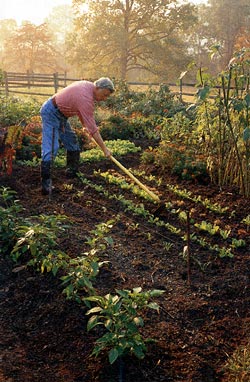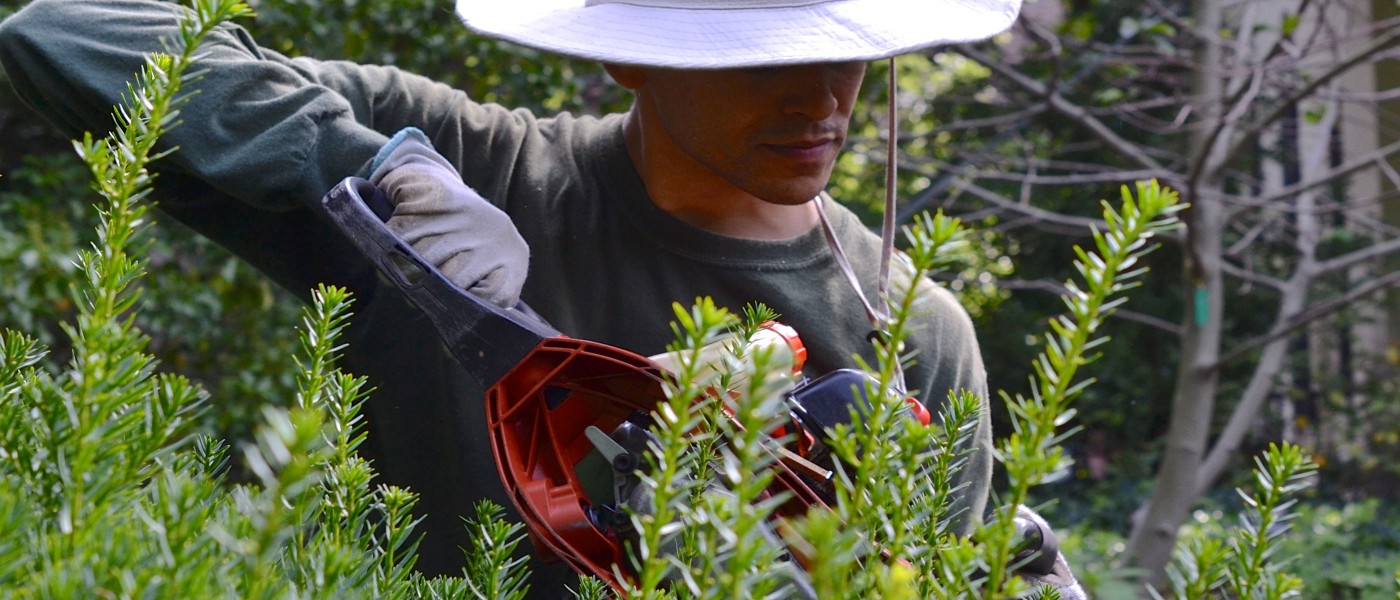100 Garden Tips and Timesavers
- Introduction
- Gardening Techniques
-
- Deadheading Annuals for Repeat Blooms
- Pinching for Compact Plants
- Saving Seeds of Annual Flowers
- The Benefits of Raised Beds
- Extend the Season With Cold Frames
- A Moss Carpet for Shade
- Keeping a Moss Lawn Tidy
- Low-Maintenance Hedges
- Pruning for Proper Hedge Shape
- When to Prune Flowering Shrubs
- Pruning Hybrid Tea Roses
- Rejuvenating Flowering Shrubs
- Take Advantage of Microclimates
- Grow Drought-Tolerant Plants
- Harvesting Rainwater
- Keeping Track of Rainfall
- Plastic Jug Irrigation
- Supporting Tall Flowers
- Protect Tree Trunks With Plants
- Edging Beds and Borders
- Containing Aggressive Plants
- Giving Caladiums a Head Start
- Spring-Bulb Basics
- Improving the Soil
-
- Winter Rye as a Cover Crop
- What to Do With Autumn Leaves
- Compost Fundamentals
- Making Compost Last Longer
- A Recipe for Compost Tea
- Lasagna Gardening
- What, When, and How to Mulch
- Making Use of Wood Ash
- Pest Controls
-
- Attracting Birds, the Ultimate Insecticide
- Safe, Easy Insecticidal Soaps
- Saving Seedlings With Cutworm Collars
- Cabbageworm Protection
- Keeping Slugs Under Control
- Deer Deterrents That Work
- Using Kitchen Supplies to Control Weeds
- Propagation
-
- Making More African Violets
- Dividing Clumps of Herbaceous Perennials
- Overwintering Plants With Cuttings
- Making More Woody Perennials
- Keeping Seeds Viable
- An Easy Way to Start Seeds
- Thinning for Healthy Seedlings
- Garden Design
-
- Creating a Garden Plan the Easy Way
- Providing Fall Color With Hardy Annuals
- Keeping Borders Colorful
- Creating Vertical Accents
- Low-Maintenance Plantings for Slopes
- Fast-Growing, Moveable Screens
- Liven Up Fall With Ornamental Grasses
- Nurture a Self-Sown Garden
- Making a Moon Garden
- Easy Monochromatic Gardens
- Container Gardening
- Container-Gardening Tips
- Great Plant Combos for Pots
- Getting Creative With Containers
- Growing Herbs in Small Spaces
- Mini-Vegetables for Containers
- Overwintering Potted Plants
- Making the Most of Portable Pots
- Gardening Indoors
- Make Your Cut Flowers Last
- Dry Flowers for Winter Bouquets
- Forcing Bulbs for Winter Bloom
- Paperwhite Narcissus: The Easiest Indoor Bulb
- Harvest Veggies From Your Windowsill
- Fresh-Picked Herbs Year-Round
- Overwintering Tender Perennial Herbs
- Safe and Easy Pest Control
- Make Your Poinsettias Last
- The Best Way to Water Houseplants
- How to Water While You're on Vacation
- Vegetables
- Weed-Free Asparagus Beds
- Harvest Beans All Summer Long
- Making More Broccoli
- Increasing Your Corn Crop
- Interplanting Corn and Pumpkin to Save Space
- Temporary Greenhouses for Seedlings
- Getting a Bumper Crop of Long-Season Veggies
- Double Your Harvest With Intercropping
- Hardy Vegetables for the Late-Season Garden
- Protecting Vegetables From Late-Season Cold
- Jump-Starting Onions, Shallots, and Garlic
- Grow Shallots in Raised Beds
- Late-Season Planting of Alliums
- Supporting Peas
- Storing Hardy Vegetables
- Six Ways to Support Tomatoes
- Ripening Tomatoes Indoors in Fall
- What to Do With a Bumper Crop
- Vertical Vegetable Gardening
- Trash to Treasure
- Compost Bins Made of Reused Materials
- Golf-Bag Tool Carrier
- Herbal Place Cards
- Homemade Soaker Hose
- Mailbox Garden Storage
- New Lives for Clay Flowerpots
- Panty Hose "Rope"
- Reusing Toy Wagons
- Index and Contributors
Introduction
Tips and Timesavers
Walter Chandoha

Gardeners share a universal problem—we don't have enough time. There simply are not enough hours in the day for our many projects: sowing, transplanting, and dividing plants; designing, building, and renovating gardens—not to mention the constant chores of weeding, pruning, and composting. There are regions of North America that allow gardening almost year–round, but most of us have just six to eight months in which to fit everything from spring planting to fall harvest cleanup. And that's in between pursuing our careers and everything else we like to do during the summer, like swimming, golfing, visiting friends, and traveling!
In my more than 40 years of dirty jeans, calloused hands, and learn–as–I–go gardening on my 46–acre farm in northwestern New Jersey, I have planted many gardens with flowers, vegetables, fruits, herbs, and ornamental grasses. I've tried to make the most of my time in the garden by using a combination of inspiration, ingenuity, and a fair amount of common sense to find shortcuts to a beautiful, healthy, abundant garden.
Among the nine chapters in this handbook are "Gardening Techniques," "Improving the Soil," "Pest Controls," "Propagation," and "Vegetables," which include tips and techniques I've used over the years to protect and enhance the soil, save time and effort in watering, and extend the blooming or growing seasons of my flowers and vegetables.
As part of my career as a nature photographer, I've experimented with garden designs to achieve exciting color, texture, and composition in borders and container gardens throughout the seasons. The tips in "Garden Design" and "Container Gardening" will help you plan and create your own garden environments. In "Gardening Indoors" are ways to expand the space and season limits of your garden by growing plants indoors, as well as methods for preserving flowers and herbs for enjoyment year–round.

Finally, in "Trash to Treasures," I have applied my tendency toward frugality—something that seems to come naturally to gardeners—to think of ways to reuse materials on hand. None of the tips in this handbook call for materials fancier than cement blocks or wooden boards, and many call for recycling household "junk" like plastic jugs or items that have outlived their original use. For example, it dawned on me that my old golf bag and cart—fallen into disuse as my passion for gardening overtook my love of golf—would make a great carrier for long–handled tools. Not only does it work well in its new capacity but I've saved three or four cubic feet of landfill space.
100 Garden Tips and Timesavers has color-coded chapter bars for quick reference to general topics like gardening techniques and vegetables, and each tip is described with step–by–step instructions. Keep it handy for inspiration—it can even go with you to the garden, perhaps nestled in your golf–bag tool carrier!
Purchase

